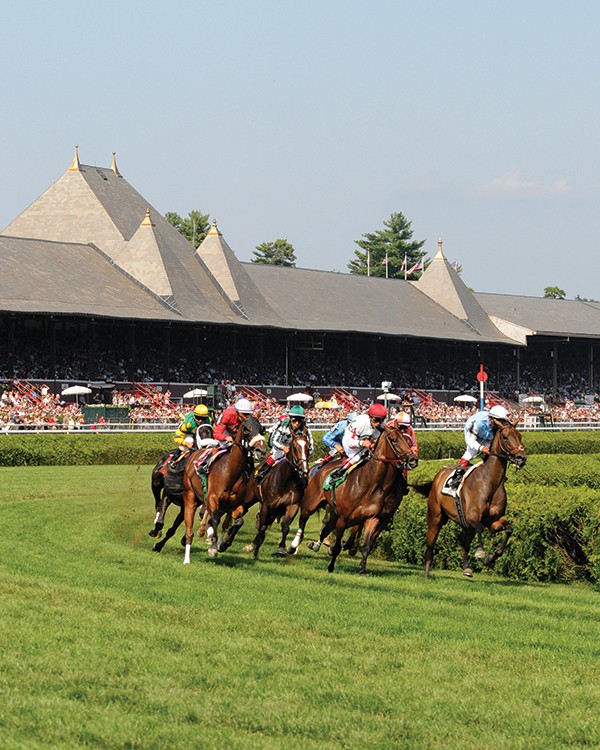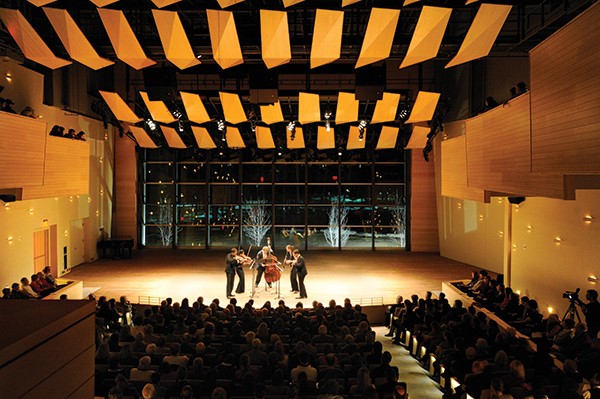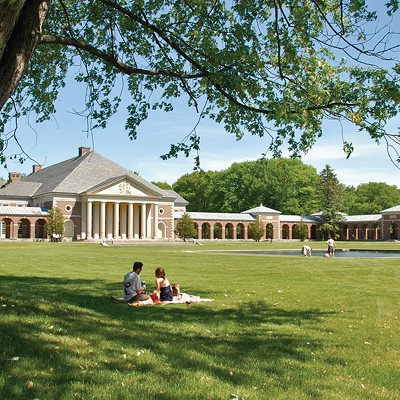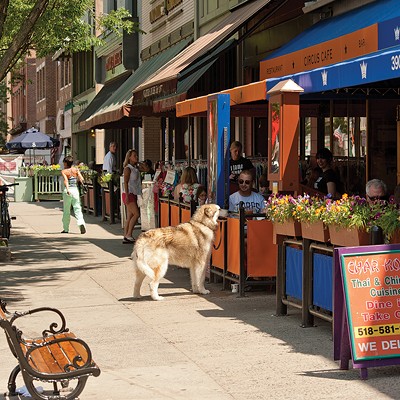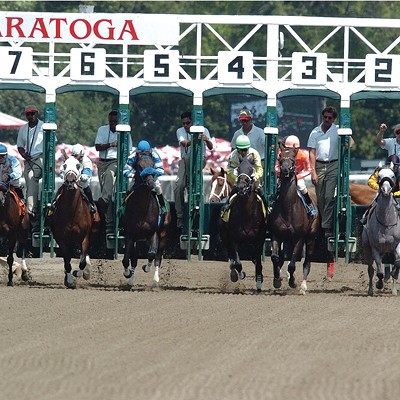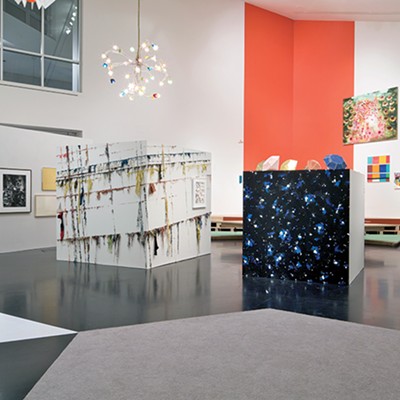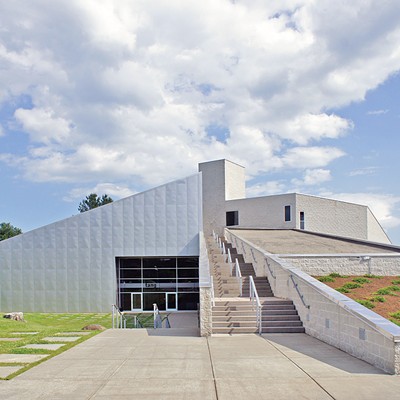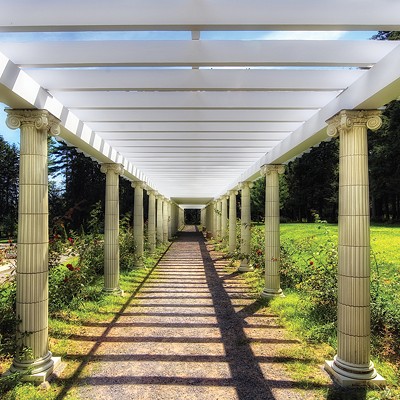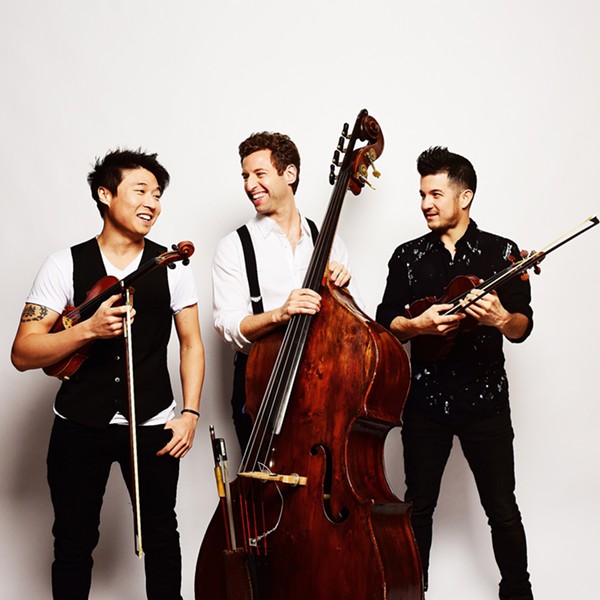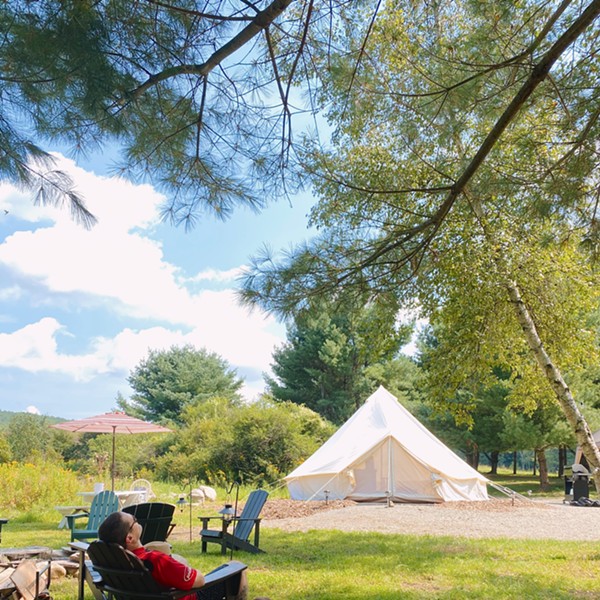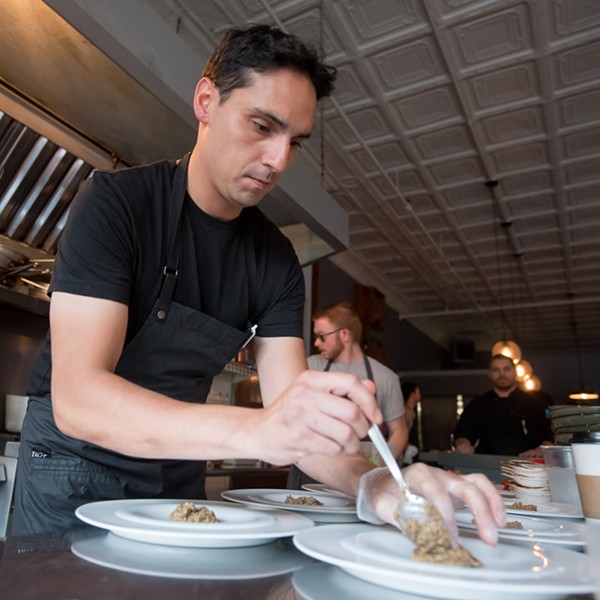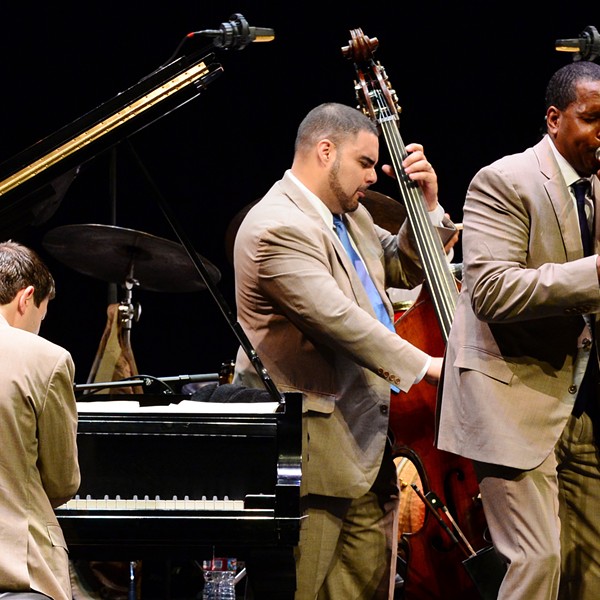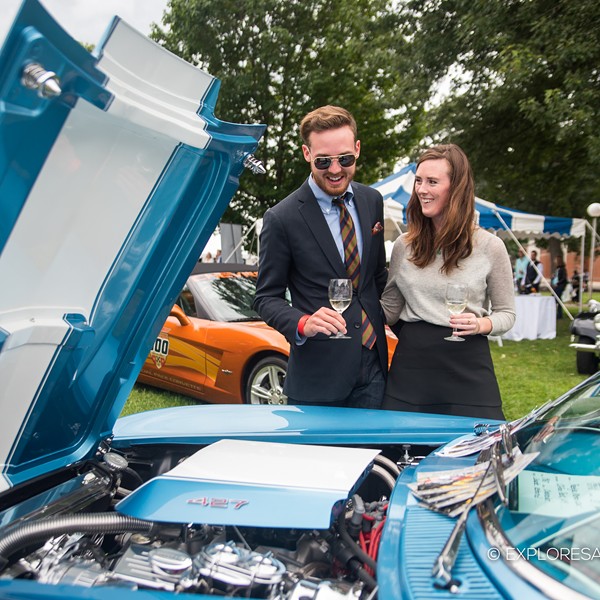Saratoga Springs is a tourist destination every summer, when the main drag of Broadway fills with visitors who come for the Saratoga Race Course's 40-day meet. One of the top thoroughbred horse-racing venues in the country, the track is also the oldest. It turns 150 this year, and in honor of the sesquicentennial, city merchants and institutions plan to throw the "biggest birthday bash Saratoga has ever seen," with scores of Saratoga 150 parties, exhibits, and performances throughout the summer.
John Morrissey, an Irish-born boxer and New York City gang member—and later a US Congressman backed by the notorious Tammany Hall—introduced organized horse racing to Saratoga Springs in 1863 as the Civil War raged. It was Morrissey's dream to bring gambling to the Saratoga area, already a major resort drawing throngs of health seekers to its reportedly curative mineral springs.
Morrissey realized his vision as tourists flocked to the "Queen of the Spas" for casino gambling and thoroughbred racing, setting the stage for a long-simmering battle over Saratoga's identity as a health resort versus an iniquitous gambling den. It's one that could flare up again as Governor Cuomo weighs a proposed $30 million expansion of Saratoga Casino & Raceway, a harness racetrack with electronic slot machines, into a full-scale casino.
Meanwhile, local growers have filled fields with flowers to be harvested for a Saratoga 150 Floral Fête promenade on August 2, when flower-festooned horse-drawn carriages and antique cars from the Saratoga Automobile Museum will parade down Broadway—harkening back to the Gilded Age when a wealthy merchant organized floral festivals in an attempt to counteract Saratoga's less savory gambling elements.
It may seem counterintuitive to toast the track's birthday by honoring one of Saratoga's most prominent Victorian-age moral crusaders, but Saratoga philanthropist Marylou Whitney was behind the idea. "The Whitney legacy is tied to the Floral Fête era, when William C. Whitney saved the track," she said back in May. True enough, her late husband's family is credited with establishing Saratoga Race Course as the reputable, family-friendly place it is today, after rescuing it from unscrupulous ownership in the 1890s.
The Mineral Cure
Against the backdrop of the summer's many Saratoga 150 events in honor of racing, it may appear as if Saratoga's original lure—the only naturally carbonated mineral springs east of the Rocky Mountains—has lost its luster from the days when crowds of tourists traveled by steamship or horse-drawn carriage to "take the cure" by bathing, inhaling and drinking the springs in.
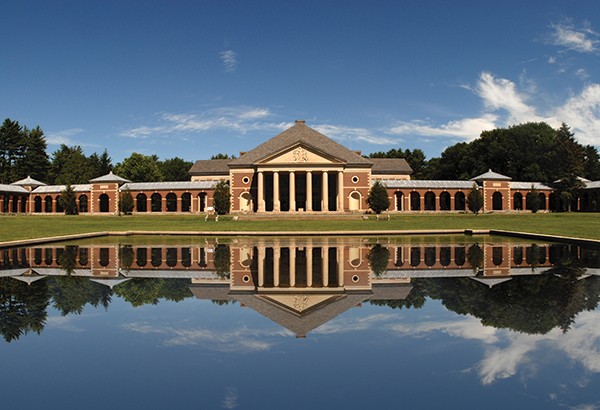
Although Saratoga Spring Water, known by the distinctive blue glass bottles, is indeed bottled locally at a plant on Geyser Road, the best place to experience Saratoga's famed mineral water is at Saratoga Spa State Park. The springs, nearly depleted in the 19th century by entrepreneurs who harvested and sold their carbonation, were protected when New York state took ownership, creating an 800-acre state reserve in 1909 and later a state park.
A park trail winds through woods along Geyser Creek to two of the most visited springs: Island Spouter, which shoots a plume of water 15 feet into the air, and Orenda Spring with its own ever-growing dome of deposited "tufa" minerals. The park offers maps and occasional guided tours of the springs and the complex's classical architecture dating back to Franklin D. Roosevelt's tenure as New York governor.
"Saratoga Spa State Park is one of the premiere destinations in the entire state park system," says Alane Ball Chinian, Saratoga-Capital Region director for the New York State Office of Parks, Recreation, and Historic Preservation. "It has fantastic architecture and history, spouting mineral springs and beautiful natural areas to explore."
Alongside a number of biking and hiking trails—and two golf courses—Spa State Park also houses the Roosevelt Baths & Spa, where visitors can soak in rust-colored, heated mineral water, and two pool complexes. The Victoria Pool offers a bar, gorgeous landscaping, arcaded brick galleries, and great people watching, while the more kid-friendly Peerless Pool has a slide.
The Saratoga Performing Arts Center (SPAC) is part of the park as well. Its amphitheater, surrounded by sloped lawn and pine trees, is the summer home of the New York City Ballet, the Philadelphia Orchestra, and pop-music concerts booked by Live Nation. Controversy still simmers over SPAC's financially fueled decision to shorten the ballet residency to one week in July this year, while the orchestra honors Saratoga 150 with the premiere of Serenade on August 8, a new piece written by Grammy-winning composer Richard Danielpour in honor of the occasion.
Horse Culture
At heart, Saratoga Springs is a horse town—more so, even, than a gambling town. Attending the races, which start this year on July 19 and conclude on Labor Day weekend, is the best way to experience it, whether you arrive before the gates open in the morning to claim a picnic table on the shaded lawn area or straggle in later for a seat on the unshaded benches by the turf, where horses thunder by on their way to the finish line.
A behind-the-scenes view of the track is best obtained at breakfast time, when free tram tours (aside from the "dark day" of Tuesday when the track is closed) give an inside look at the backstretch area, where horses are cared for by the hundreds of grooms, riders, and hot-walkers who lug water buckets, rub down horses, and heft hay to keep the horses bathed, fed and exercised. Beginning this year, the New York Racing Association—the often-embattled nonprofit racing association that operates the New York tracks of Aqueduct, Belmont Park and Saratoga—will also offer paid guided tours between 9 a.m. and 4 p.m. focusing on track history.
The history of racing can be further explored at the National Museum of Racing and Hall of Fame, one of Saratoga's finest museums, located across the street from the racecourse on Union Avenue. It has a courtyard statue of the beloved racehorse Secretariat, galleries of memorabilia and a racing simulator that replicates the physical demands and unbelievable speed of a typical thoroughbred race.
Arts & Letters
The cultural life of Saratoga Springs comes alive in the summer as well. Of all the grand hotels that once lined Broadway in the Victorian era but later burned or were razed, only the Adelphi Hotel remains. Built in 1877, its foliage-filled garden patio provides one of the best spots to absorb Saratoga's storied past. The hotel changed owners last year, but the new owners—a local real estate development team—have pledged to keep the Adelphis's historic charm intact.
Yaddo, the famed artist's retreat, is located on the former estate of Spencer and Katrina Trask—philanthropists and arts supporters who voiced significant opposition to Saratoga's turn toward gambling in the late 1880s. Rarely does Yaddo offer the public a glimpse inside its mansion, where artists, musicians, and authors go for a quiet place to create, but the estate's enchanting gardens are open to the public seven days a week from dusk to dawn.
Other summer cultural highlights include the intimate brick-walled bar 9 Maple Avenue, known for its weekend night jazz performances and massive collection of single-malt scotches, and the cultural offerings of Skidmore College: Its inventive Tang Teaching Museum and Art Gallery, Arthur Zankel Music Center, and Summer Writer's Institute with a full slate of author readings in July.
Saratoga food culture has steadily improved over the past decade, with the popular Saratoga Farmers Market a focal point for chefs picking up local produce, meats, and cheeses to serve in their restaurants. Hattie's Chicken Shack, a soul food joint on Phila Street, is one local food institution in particular that celebrates Saratoga's connection to the past. A Saratoga institution in the late '30s and '40s when the city swung with speakeasies and smoky mob-connected clubs, it was started by Hattie Gray, an African-American woman who worked summers for a local family before saving her money to open her own place.
Hattie's celebrates its 75 anniversary this year. "This type of longevity for any business is rare but for a restaurant it is almost unheard of," says current chef and owner Jasper Alexander. "Grandparents that were first brought to Hattie's as children by their grandparents now bring their grandchildren to the restaurant."
Venturing North
Saratoga lies just below the Adirondack Mountain foothills, a close destination for visitors looking to explore the wilds of the largest state-level protected area in the contiguous United States. From Saratoga Springs, popular trips include Blue Mountain Lake's Adirondack Museum, with galleries and historic buildings filled with exhibits on logging, boating, and other facets of Adirondack life, while tours of Gilded Age retreats like the Great Camp Sagamore, now a National Historic Landmark, can be found in Raquette Lake.
The famous camps of Raquette Lake, developed by William West Durant, were owned by Gilded Age barons like Alfred Vanderbilt and J. P. Morgan. "Historically important, they embodied the way the Gilded Age roughed it in the woods while Newport, Rhode Island's cottages manifested the beach holidays of the era," says Barbara Glaser, a Saratoga Springs resident who helped spearhead the drive to save the historic site from decay in the 1970s.
Just to the north of Saratoga, the Lake George region is popular for boating, fishing, the Great Escape Theme Park and its many tacky diversions on Canada Street, while further afield, Lake Placid is the quintessential Adirondack town, containing not just beautiful nature but also Olympic history and culture, most notably, when the Lake Placid Film Festival hits town every year in June.
Resources
Holiday Inn Saratoga Springs (518) 584-4550
National Museum of Dance
Saratoga Dance







